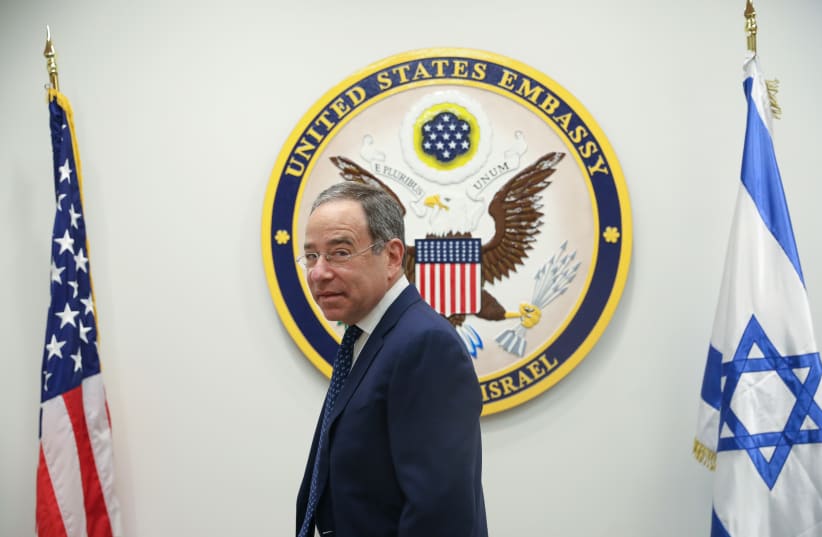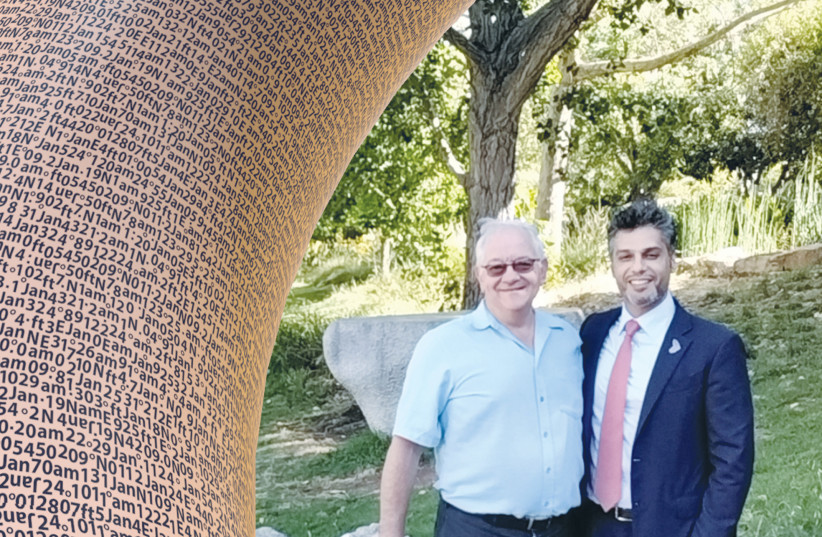■ IN LAST Wednesday’s Grapevine, mention was made of the fact that French Ambassador Eric Danon was bringing Bastille Day forward. The presumption was that it shouldn’t clash with the visit to Israel of US President Joe Biden. Celebrating Bastille Day during the visit would put an even greater strain on Jerusalem-based French Consul-General René Troccaz, whose residence is located just off King David Street, which will frequently be closed to traffic while POTUS is in the capital. Troccaz is waiting for all the excitement to abate and will be hosting his traditional Bastille Day reception on July 18.
■ MEANWHILE, A reassuring tweet came on Tuesday night from US Ambassador Tom Nides in which he wrote that he had just left the White House, and that “Everyone is pumped up to come to Israel for a busy and exciting schedule with POTUS Biden.”
■ THERE ARE always killjoys and spoilsports whose raison d’etre is to rain on other people’s parades. Thus it came as no surprise to find standing outside the Jerusalem Theater a relatively small but significant group of anti-vaxxers bearing signboards with crude messages, banging drums and shouting insults through a megaphone. Inside the theater, however, were more than 900 people giving standing ovations to Genesis Prize recipient and Pfizer chairman and CEO Dr. Albert Bourla.
The theme of the evening, as repeated several times by emcee Sarah Rafferty, was healing and hope. Bourla symbolizes both. Rafferty, who is best known for her role as Donna Paulson in the legal drama Suits, said that she is currently contracted to play in other productions. She also said that she had never expected to meet Bourla in person, and was extremely grateful on behalf of her family, who had benefited from him. She also thanked him for having given her some of his time, during which time he quoted Greek philosophers.
Former Israel ambassador to the US Ron Dermer said that Bourla was deserving not only of the Genesis Prize, often referred to as the “Jewish Nobel Prize,” but that he is also deserving of the Swedish Nobel Prize. Every speaker for the evening related to the traditional Jewish belief that he who saves a single life saves a whole world. They noted that Bourla, with his determination to see Pfizer quickly produce a life-saving vaccine, had saved untold millions of worlds. Bourla himself, noting the presence of two of his predecessors Robert Kraft and Natan Sharansky, listed some of their attributes, and said he was honored to be mentioned in the same breath as them.
One of the reasons that Bourla was chosen to receive the Genesis Prize was for his strong commitment to his Jewish heritage and to the State of Israel. In response, he said that inasmuch as he is proud of his Jewish heritage, he is equally proud of being Greek. Here again, he quoted Greek philosophers. His favorite such philosopher was his mother, Sara, who based on her own experience on miraculously being saved at the last minute from a Nazi execution squad, told him repeatedly that nothing is impossible.
It was only natural that one of the entertainers for the evening should be Yehuda Poliker, whose parents, like Bourla’s, were Holocaust survivors from Thessaloniki. The audience went wild over Poliker, and clapped along with the music, emitting a huge cheer of appreciation as he played the final chord on his guitar. Outside, the anti-vaxxers continued to display the art of rudeness, indignity and disrespect. As the saying goes, it takes all kinds to make a world.
Embassies moving to Jerusalem
■ MANY AMBASSADORS whose governments have so far declined moving their embassies to Jerusalem, nonetheless like to spend time in Israel’s capital. They often come not only on official business, but for weekend vacations, and even during the week to explore the city’s various attractions. One such ambassador is Mohamed Al Khaja, of the United Arab Emirates. A few days after enjoying a tour of the Israel Museum, he was given a tour of the extensive Jerusalem Botanical Gardens (JBG) that are located on the Givat Ram campus of the Hebrew University of Jerusalem.
The gardens are much more than a horticultural museum with blooms and shrubs from all over the world – some growing successfully in vastly different soil and climates to those from which they sprouted.
Al Khaja was taken on an extensive tour of the gardens by chairman Alan Berkley and executive director for strategic development Hannah Rendell who also told him about the various community projects of the JBG and its important conservation efforts. The many projects give people from all sectors of the population a chance to feel that they are making a contribution to the natural beauty of the country.
During his visit, Al Khaja had the opportunity to experience one of the augmented reality artworks by Mohammed Kezem, a prominent artist from Dubai whose work is currently among 13 augmented-reality works of art displayed at JBG’s Seeing the Invisible exhibition.
In Mohammed Kazem’s work Directions (Zero), 2010/2021, viewers are invited to pass through a large-scale figure of the number zero on which numerous geographic coordinates, representing all countries of the world, are inscribed in numeric form. Originally conceived for the UAE and the metropolitan city of Abu Dhabi – with its population of diverse nationalities, races, and religions – the work embodies the principle of coexistence and peace, inviting viewers to pass through it as if starting anew from equal ground. As the day progresses, light, shadows and reflections over the digital structure change, further enhancing the connection between the work and its natural surroundings.
■ IN 2018, Poland’s Prime Minister Mateusz Morawiecki together with Deputy Prime Minister and Culture Minister Piotr Glinski announced plans to set up a Warsaw Ghetto Museum on Sienna Street in the Polish capital, in a building that had been a hospital within the confines of the ghetto. Established in the autumn of 1940, the Warsaw Ghetto was the largest of all the ghettos in German-occupied Europe. In the summer of 1942, more than 250,000 of its inhabitants were sent to the Treblinka death camp.
Glinski said the new museum would be a modern facility designed to educate the public about the Warsaw Ghetto as well as other ghettos and the Holocaust in general.
“I hope it will also be a symbol of Polish-Jewish brotherhood and solidarity,” he said, adding that above all, its goal was to “present the historical truth.”
This alluded to the dispute that Poland has with Israel and with Jews of Polish origin around the globe, over whether or not there were Poles who collaborated with the Nazis. Relations between Poland and Israel on this issue have been tense, especially since the enactment of Poland’s anti-defamation law, which regards any allegation of Polish collaboration with the Nazis as a criminal offence.
Relations have been further strained by Poland’s insistence on having a say on the content of information imparted to Jewish groups, particularly those from Israel who are participating in educational tours of Poland. There have also been disputes between Polish and Israeli experts of Polish-Jewish history during World War Two over the actual content of the museum.
Nonetheless, cultural relations between the two countries have continued unabated, and this week, within the framework of the Polish-funded "Inspiring Culture" project, a Polish delegation headed by Monika Krawczyk, the director of Warsaw’s Jewish Historical Institute (JHI), came to Israel to conduct a comprehensive seminar for Israeli teachers, researchers, employees of archives and cultural institutions and guides of educational tours to Poland.
The seminar was under the auspices of the JHI in cooperation with the Polish Institute in Tel Aviv, Moreshet, Mordechai Anielewicz Memorial Center for Holocaust Education and Research and Poland’s Ministry of Culture and National Heritage.
The JHI has a very close relationship with Yad Vashem, which was re-enforced during the visit by the Polish delegation.
Subjects discussed during the seminar focused mainly on different aspects of the famed Oneg Shabbat Ringelblum Archives, the work and the cultural activities of the JHI, documents and photographs from its vast collection that can be seen online, and how to utilize the JHI building and its exhibits when visiting Warsaw.
Aware of the difference between theory and practice, the organizers will host a second seminar in Warsaw on July 29 to give participants the opportunity to actually see, touch and feel much of what is being discussed. They will also get to see the progress made on the Warsaw Ghetto Museum, which will be officially opened next year on the 80th anniversary of the Warsaw Ghetto Uprising.
Despite the continuing antisemitism in Poland, the Warsaw Ghetto Uprising was commemorated annually, even in communist times, alongside the impressive monument identical to the one in Yad Vashem.
greerfc@gmail.com

